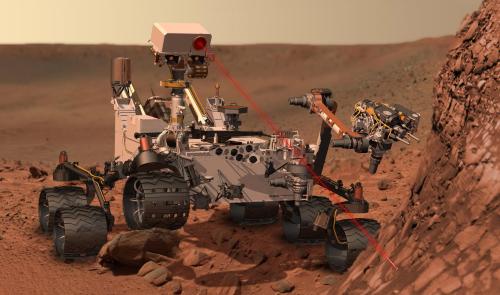CAPE CANAVERAL, Florida (AP) -- A super-size rover zoomed toward Mars on an 8{-month, 354 million-mile (570 million-kilometer) journey Saturday, the biggest, best equipped robot ever sent to explore another planet.
NASA's six-wheeled, one-armed wonder, Curiosity, will reach Mars next summer and use its jackhammer drill, rock-zapping laser machine and other devices to search for evidence that Earth's next-door neighbor might once have been home to the teeniest forms of life.

More than 13,000 invited guests jammed the Kennedy Space Center on Saturday morning to witness NASA's first launch to Mars in four years, and the first flight of a Martian rover in eight years.
Mars fever gripped the crowd.
NASA astrobiologist Pan Conrad, whose carbon compound-seeking instrument is on the rover, wore a bright blue, short-sleeve blouse emblazoned with rockets, planets and the words, ``Next stop Mars!'' She jumped, cheered and snapped pictures as the Atlas V rocket blasted off. So did Los Alamos National Laboratory's Roger Wiens, a planetary scientist in charge of Curiosity's laser blaster, called ChemCam.
Surrounded by 50 U.S. and French members of his team, Wiens shouted ``Go, Go, Go!'' as the rocket soared into a cloudy sky. ``It was beautiful,'' he later observed, just as NASA declared the launch a full success.
A few miles (kilometers) away at the space center's visitor complex, Lego teamed up with NASA for a toy spacecraft-building event for children this Thanksgiving holiday weekend. The irresistible lure: 800,000 Lego bricks.
The 1-ton Curiosity _ 10 feet (3 meters) long, 9 feet (2.7 meters) wide and 7 feet (2.1 meters) tall at its mast _ is a mobile, nuclear-powered laboratory holding 10 science instruments that will sample Martian soil and rocks, and with unprecedented skill, analyze them right on the spot.
It's as big as a car. But NASA's Mars exploration program director calls it ``the monster truck of Mars.''
``It's an enormous mission. It's equivalent of three missions, frankly, and quite an undertaking,'' said the ecstatic program director, Doug McCuistion. ``Science fiction is now science fact. We're flying to Mars. We'll get it on the ground and see what we find.''
The primary goal of the $2.5 billion mission is to see whether cold, dry, barren Mars might have been hospitable for microbial life once upon a time _ or might even still be conducive to life now. No actual life detectors are on board; rather, the instruments will hunt for organic compounds.
Curiosity's 7-foot (2.1-meter) arm has a jackhammer on the end to drill into the Martian red rock, and the 7-foot (2.1-meter) mast on the rover is topped with high-definition and laser cameras.
With Mars the ultimate goal for astronauts, NASA will use Curiosity to measure radiation at the red planet. The rover also has a weather station on board that will provide temperature, wind and humidity readings; a computer software app with daily weather updates is planned.
No previous Martian rover has been so sophisticated.
The world has launched more than three dozen missions to the ever-alluring Mars, which is more like Earth than the other solar-system planets. Yet fewer than half those quests have succeeded.
Just two weeks ago, a Russian spacecraft ended up stuck in orbit around Earth, rather than en route to the Martian moon Phobos.
``Mars really is the Bermuda Triangle of the solar system,'' said NASA's Colleen Hartman, assistant associate administrator for science. ``It's the death planet, and the United States of America is the only nation in the world that has ever landed and driven robotic explorers on the surface of Mars, and now we're set to do it again.''
Curiosity's arrival next August will be particularly hair-raising.
In a spacecraft first, the rover will be lowered onto the Martian surface via a jet pack and tether system similar to the sky cranes used to lower heavy equipment into remote areas on Earth.
Curiosity is too heavy to use air bags like its much smaller predecessors, Spirit and Opportunity, did in 2004. Besides, this new way should provide for a more accurate landing.
Astronauts will need to make similarly precise landings on Mars one day.
Curiosity will spend a minimum of two years roaming around Gale Crater, chosen from among more than 50 potential landing sites because it's so rich in minerals. Scientists said if there is any place on Mars that might have been ripe for life, it may well be there.
The rover should go farther and work harder than any previous Mars explorer because of its power source: 10.6 pounds (4.8 kilograms) of radioactive plutonium. The nuclear generator was encased in several protective layers in case of a launch accident.
NASA expects to put at least 12 miles (19 kilometers) on the odometer, once the rover sets down on the Martian surface.
McCuistion anticipates being blown away by the never-before-seen vistas. ``Those first images are going to just be stunning, I believe. It will be like sitting in the bottom of the Grand Canyon,'' he said at a post-launch news conference.
This is the third astronomical mission to be launched from Cape Canaveral by NASA since the retirement of the venerable space shuttle fleet this summer. The Juno probe is en route to Jupiter, and twin spacecraft named Grail will arrive at Earth's moon on New Year's Eve and Day.
Unlike Juno and Grail, Curiosity suffered development programs and came in two years late and nearly $1 billion over budget. Scientists involved in the project noted Saturday that the money is being spent on Earth, not Mars, and the mission is costing every American about the price of a movie.
``I'll leave you to judge for yourself whether or not that's a movie you'd like to see,'' said California Institute of Technology's John Grotzinger, the project scientist. ``I know that's one I would.''
<한글기사>
美 '꿈의 화성탐사선' 큐리오시티호 발사
역대 최대 규모의 화성 무인 탐사선인 큐리오시티호가 26일(현지시간) 화성을 향한 장도에 올랐다.
미 항공우주국(NASA)은 큐리오시티호를 실은 아틀라스 V 로켓을 이날 아침 10시 2분께 플로리다주(州) 케이프 커내버럴 공군기지에서 발사했다.
큐리오시티호는 정상적으로 궤도 진입에 성공하면 8개월 보름간 약 5억7천만 km 를 항해, 내년 8월에 화성 적도 바로 아래의 분화구인 게일 크레이터에 착륙한다.
이후 2년여 간 표면을 탐사하며 미생물 등 생명체의 존재 가능성 등을 조사하게 된다.
로봇 탐사선 큐리오시티호는 길이 약 3m에 너비 약 2.7m, 무게 약 1t으로 지금 까지 만들어진 지구권 바깥 우주 탐사선 중 최대 규모이며 가장 정교한 장비를 갖추 고 있어 '꿈의 탐사선'으로 불리고 있다.
첨단 카메라와 무선 분석장비 등 대량의 과학 장비를 싣고 화성 표면을 돌아다 니며 2.1m 길이의 대형 로봇팔을 이용해 다양한 고도에서 암석과 토양 샘플을 채취 해 분석할 예정이다.
탐사선은 표면 착륙 때 로봇에 매달린 로켓의 추진력으로 고도를 조절하며, 바 닥에 닿기 직전에 몸체에서 바퀴 6개와 서스펜션이 튀어나오도록 설계됐다.
공식 명칭이 '화성과학실험실(MSL)'인 큐리오시티 프로젝트에는 총 25억달러(약 2조8천억원)의 예산이 투입됐다.
이날 케이프 커내버럴 기지에는 1만3천여명의 관중이 모여 발사 장면을 지켜보 며 환호했다.




![[Herald Interview] 'Amid aging population, Korea to invite more young professionals from overseas'](http://res.heraldm.com/phpwas/restmb_idxmake.php?idx=644&simg=/content/image/2024/04/24/20240424050844_0.jpg&u=20240424200058)














![[Today’s K-pop] Kep1er to disband after 2 1/2 years: report](http://res.heraldm.com/phpwas/restmb_idxmake.php?idx=642&simg=/content/image/2024/04/25/20240425050792_0.jpg&u=)